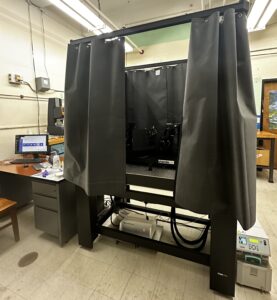
The LS Spectrometer by LS Instruments is a shared instrument located in LRSM 10. It can operate in both static light scattering (SLS) and dynamic light scattering (DLS) modes.
The instrument is equipped with a 3D Cross-correlation capability that enables it to distinguish intensity decorrelation that originates from single vs multiple scattering events. As a result, the instrument can be used to collect dynamic light scattering data from samples that exhibit multiple scattering, i.e. concentrated, opaque systems. The Modulated 3D Cross-Correlation option enhances the signal from the cross-correlation measurement. Additional options include sample rotation (for measurements of non-ergodic systems), and temperature resolved measurements.
Standard measurements:
- Particle sizing: hydrodynamic Radius (Rh) and radius of gyration (Rg)
- Size distribution and polydispersity
- Particle dynamics: diffusion coefficient, mean square displacement,
- Polymer molecular weight (MW ~ 360 – 3600000 Dalton)
- 2nd virial coefficient
- Rayleigh ratio
- Form and structure factors
- Inter-particle distance in charged systems
- Aggregation
- Etc.
Specifications:
| Sample volume | 50 μL to 4 ml |
| Particle size range (Rh) | 0.15 nm to 5 μm |
| Radius of gyration (Rg) | 5 nm to 5 μm |
| Molecular weight | 360 – 3,600,000 Dalton |
| Angular range | 12° to 150° (+/- 0.01°) Recommended 15° to 150° |
| Laser | Cobolt 300mW 660nm |
| Correlator | 320 channels, delay time 12.5 ns to 15 h, auto- and cross-correlation |
| Temperature | up to 90 °C |
For light scattering tutorials:
- LS Spectrometer User Manual
- LS Instrument Training Presentation
- Manual Zim Plot
- Reports and Additionals (Access request needed for download)
- Python Code Demo for Plotting
- Abbe Refractometer SOP
Location:
